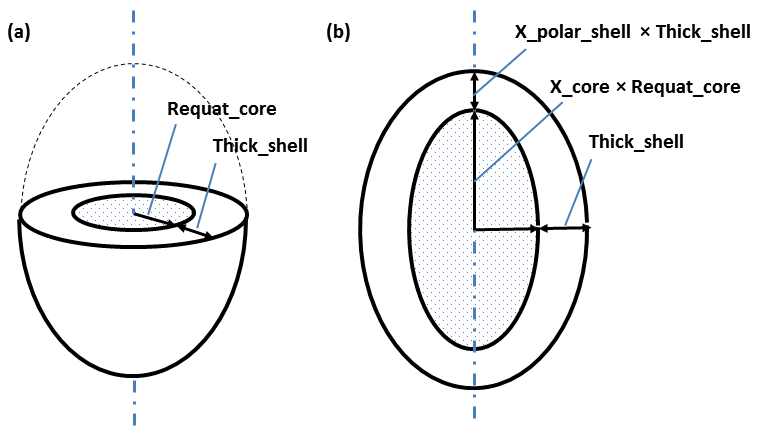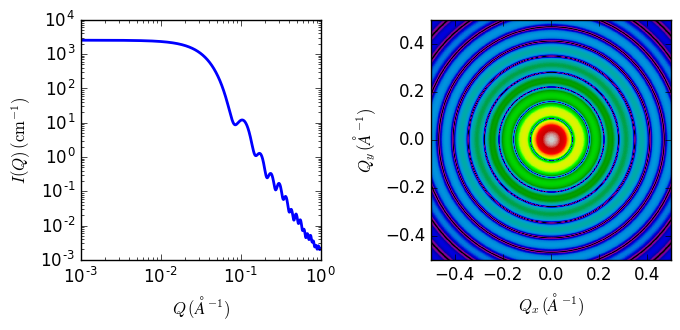core_shell_ellipsoid
Form factor for an spheroid ellipsoid particle with a core shell structure.
| Parameter | Description | Units | Default value |
|---|---|---|---|
| scale | Source intensity | None | 1 |
| background | Source background | cm-1 | 0.001 |
| radius_equat_core | Equatorial radius of core | Å | 20 |
| x_core | axial ratio of core, X = r_polar/r_equatorial | None | 3 |
| thick_shell | thickness of shell at equator | Å | 30 |
| x_polar_shell | ratio of thickness of shell at pole to that at equator | None | 1 |
| sld_core | Core scattering length density | 10-6Å-2 | 2 |
| sld_shell | Shell scattering length density | 10-6Å-2 | 1 |
| sld_solvent | Solvent scattering length density | 10-6Å-2 | 6.3 |
| theta | Oblate orientation wrt incoming beam | degree | 0 |
| phi | Oblate orientation in the plane of the detector | degree | 0 |
The returned value is scaled to units of cm-1 sr-1, absolute scale.
Definition
Parameters for this model are the core axial ratio X and a shell thickness, which are more often what we would like to determine and makes the model better behaved, particularly when polydispersity is applied than the four independent radii used in the original parameterization of this model.

The geometric parameters of this model are shown in the diagram above, which shows (a) a cut through at the circular equator and (b) a cross section through the poles, of a prolate ellipsoid.
When X_core < 1 the core is oblate; when X_core > 1 it is prolate. X_core = 1 is a spherical core.
For a fixed shell thickness XpolarShell = 1, to scale the shell thickness pro-rata with the radius set or constrain XpolarShell = X_core.
When including an \(S(q)\), the radius in \(S(q)\) is calculated to be that of a sphere with the same 2nd virial coefficient of the outer surface of the ellipsoid. This may have some undesirable effects if the aspect ratio of the ellipsoid is large (ie, if \(X << 1\) or \(X >> 1\) ), when the \(S(q)\) - which assumes spheres - will not in any case be valid. Generating a custom product model will enable separate effective volume fraction and effective radius in the \(S(q)\).
If SAS data are in absolute units, and the SLDs are correct, then scale should be the total volume fraction of the “outer particle”. When \(S(q)\) is introduced this moves to the \(S(q)\) volume fraction, and scale should then be 1.0, or contain some other units conversion factor (for example, if you have SAXS data).
The calculation of intensity follows that for the solid ellipsoid, but with separate terms for the core-shell and shell-solvent boundaries.
where
where
and
\(\alpha\) is the angle between the axis of the ellipsoid and \(\vec q\), \(V = (4/3)\pi R_pR_e^2\) is the volume of the ellipsoid , \(R_p\) is the polar radius along the rotational axis of the ellipsoid, \(R_e\) is the equatorial radius perpendicular to the rotational axis of the ellipsoid and \(\Delta \rho\) (contrast) is the scattering length density difference, either \((sld\_core - sld\_shell)\) or \((sld\_shell - sld\_solvent)\).
For randomly oriented particles:

Fig. 34 1D and 2D plots corresponding to the default parameters of the model.
References see for example: Kotlarchyk, M.; Chen, S.-H. J. Chem. Phys., 1983, 79, 2461. Berr, S. J. Phys. Chem., 1987, 91, 4760.
Authorship and Verification
- Author: NIST IGOR/DANSE Date: pre 2010
- Last Modified by: Richard Heenan (reparametrised model) Date: 2015
- Last Reviewed by: Richard Heenan Date: October 6, 2016